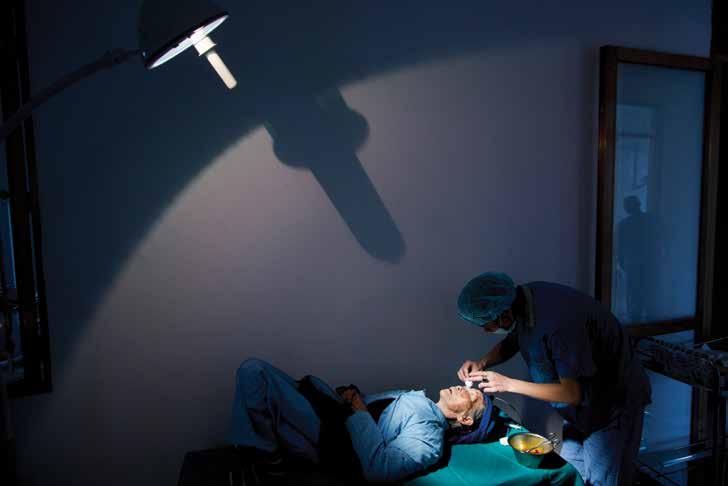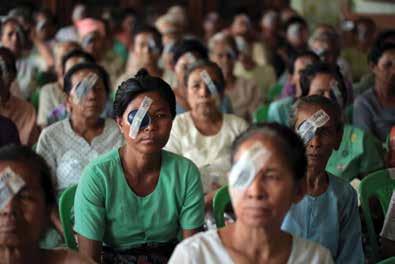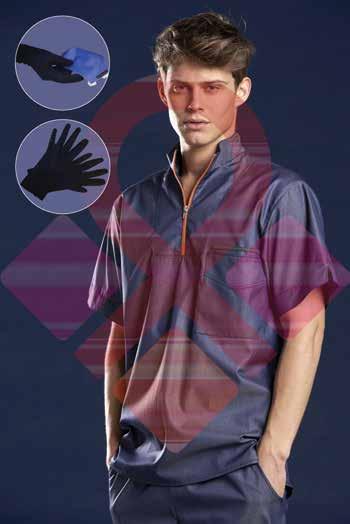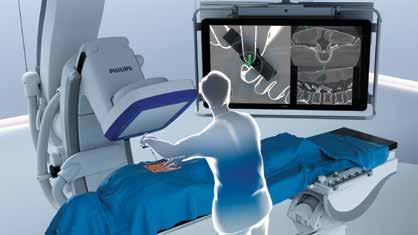
6 minute read
Finding sustainable ways to address gender inequity in eye health
Ophthalmology
By Rashin Choudhry Program Development Advisor, The Fred Hollows Foundation
More than 20 million women are blind and a further 120 million live with vision impairment. We know that four out of five people who are blind do not need to be, yet women are 1.3 times more likely to be blind than men.
In the Middle East, women are experiencing higher rates of blindness than men in countries where The Fred Hollows Foundation works. In Palestine, for example, women make up 70% of blind people aged 50 years or older.
Blindness can hamper a woman’s ability to access education, generate income, or perform day-to-day activities. It can deny women in low- and middle-income countries their social inclusion, participation, and voice as well as an individual’s independence, choice, and autonomy.
Barriers to accessing eye healthcare services vary from one country to another. They are created by biological reasons, misconceptions, traditional gender roles, and financial, social and cultural factors.
Implementing a gender equity and mainstreaming approach is a must to achieve equitable access for men and women, but also close the gender gap in eye health. In countries like Pakistan, women often do not know about the eyecare services available or may not have someone to accompany her to the clinic. Taking services to the doorstep of women can help them to receive the care they need, especially in rural and remote areas.
The gender of eye healthcare workers can also be a critical factor in influencing decision making among female patients to accept or decline treatment
Poverty
Almost 90% of women who are blind are living in poverty. Poverty remains a cause and effect for eye health patients as they are not able to access eye care. Community-based service delivery models can tackle the financial barrier and ensure women can access free or low-cost eye care.
Men are our allies and can help to support women who lack decision-making power on their own health, as well as their financial needs and literacy. The Foundation encourages husbands, fathers, religious leaders, politicians, and female health workers to join its efforts in raising women’s awareness about avoidable blindness, promoting eye health services, and encouraging them to seek treatment.
Pandemic
The coronavirus pandemic has placed enormous burdens on healthcare systems. The negative impact has extended to people with pre-existing conditions, such as patients living with eye diseases like cataracts. It has severely restricted patients’ ability to see ophthalmologists, caused them to miss follow-up appointments, or receive treat-
ments. In Palestine and Pakistan, more than 68,000 eye patients could not access services at our local partner hospitals.
To ensure eye care patients are not left behind – especially elderly women and disabled people – telehealth has been introduced to our projects in Pakistan, Nepal, and Bangladesh. Telehealth allows women living with vision impairment to receive eye care without being physically at the health provider. Women could continue accessing diagnostics and treatment services from health providers despite the pandemic and geographical challenges.
The pandemic has also affected the global economic system. As a result, millions of people’s livelihoods have been impacted by this economic crisis and added more financial pressure on marginalized communities including women and disabled people, especially in low resource settings.
We have to ensure patients can access free or low-cost packages of preventions, interventions, treatments, and management. These locally-based packages are crucial to create sustainable change in eye health during pandemic times.
The burden of this global pandemic did not stop at the healthsystem level, but also extended to healthcare workers. It is very important to look after our frontline healthcare workers, especially women who are stressed at work and home.


Gender
We must ensure strong gender analysis informs the design of all new programmes, and we work to ensure sex disaggregated data is collected, analysed and used to inform programme management, planning and advocacy.
Projects should be designed by looking at health systems with strengthening and sustainability approach and not a vertical standalone activity. This requires collaboration between programmes, advocacy, research teams and local partners who can help maximise sustainable efforts to reduce gender inequity in eye health. Teams ensure they are delivering evidence-based programming, policy, and advocacy, implementing projects which are contextually appropriate, optimizing the use of existing local resources, and evaluating impact through a genderresponsive framework.
Barriers to eye care for women cannot be ignored and should be identified, addressed, and removed to ensure no-one is left behind.
Eye heath actors must develop locally-based solutions and ensure integration between programmes, advocacy and medical research to achieve both gender equity and sustainable efforts to end avoidable blindness.
The Fred Hollows Foundation
The Fred Hollows Foundation is an international development organisation working to deliver a world in which no person is needlessly blind or vision impaired. Visit: www.hollows.org


Equipe
Reusable antiviral clothes, gloves and caps
Equipe MedCon GmbH is the proud distributor of the PASTELLI line of surgical clothes, gloves and caps.
The surgical clothes, gloves and caps are treated with a certified antiviral and antibacterial treatment and keep their protection even after many washes.
This clothing line, designed and produced in Italy, provides the perfect antiviral protection and they are reusable.
They are very comfortable and stylish.
The cost per usage is comparable to a disposable cloth.
The beautiful and comfortable gloves are the latest addition to this line. They are washable at least 30 times. They provide protection to users even in the most contaminated areas.
All products are PPE labelled. They have the CE mark and have undergone testing according to strict European standards. • For more information, visit: www.pastelli.com
Philips has introduced ClarifEye Augmented Reality Surgical Navigation, an industry-first solution to advance minimally-invasive spine procedures in the Hybrid Operating Room.
By combining superb 2D and 3D visualizations at low X-ray dose with 3D augmented reality (AR), the unique solution provides live intra-operative visual feedback to support accurate placement of pedicle screws during spinal fusion procedures.
Four high-resolution optical cameras are used to augment the surgical field with 3D cone-beam CT imaging, without the need for additional X-ray. The system combines the view of the surgical field with the internal 3D view of the patient to construct a 3D augmented-reality view of the patient’s external and internal anatomy. Consistent tracking of the patient is ensured by video


Philips introduces ClarifEye Augmented Reality Surgical Navigation for spinal procedures

tracking of non-invasive markers placed on the skin. The system then visualizes the tip of the ClarifEye Needle as it is navigated along the planned path in the spine.
The solution is fully integrated into the Philips Azurion image-guided therapy platform, supporting efficient workflow with intra-procedural navigation and verification for accurate screw placement and reducing the need for post-operative CT scans.
By taking a minimally invasive approach to spine surgery, patients can benefit from reduced postoperative pain, shortened hospital stays, reduced blood loss, and minimized soft tissue damage and scar tissue. In addition, the intra-operative image guidance provided by solutions such as ClarifEye increases clinical accuracy, with patients subject to fewer revision surgeries compared to the current standard of care.
“In spine surgery, when you change your approach to a minimally invasive one, you also have to change the way you operate because you need another way to see inside the spine,” said Dr Pietro Scarone, Neurosurgeon at Ente Ospedaliero Cantonale in Lugano, Switzerland. “With ClarifEye, the technology adapts to the needs of the surgeon, rather than the surgeon adapting to the requirements of the technology.” • For information, see this YouTube video. https://youtu.be/TwZGT1KGvq4











